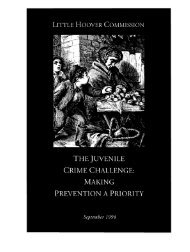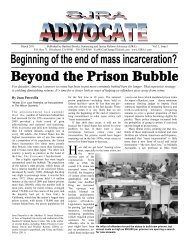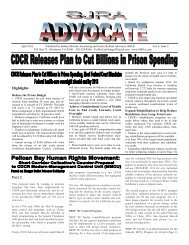Jailhouse Lawyer's Handbook - Sentencing and Justice Reform ...
Jailhouse Lawyer's Handbook - Sentencing and Justice Reform ...
Jailhouse Lawyer's Handbook - Sentencing and Justice Reform ...
You also want an ePaper? Increase the reach of your titles
YUMPU automatically turns print PDFs into web optimized ePapers that Google loves.
the public eye <strong>and</strong> had some positive effects on the way<br />
federal courts dealt with prisoners. Prisoners won<br />
important federal court rulings on living conditions,<br />
access to the media, <strong>and</strong> procedures <strong>and</strong> methods of<br />
discipline.<br />
Unfortunately, the federal courts did not stay receptive<br />
to prisoners’ struggles for long. In 1996, Congress<br />
passed <strong>and</strong> President Clinton signed into law the Prison<br />
Litigation <strong>Reform</strong> Act (PLRA). The PLRA is<br />
extremely anti-prisoner, <strong>and</strong> designed to limit<br />
prisoners’ access to the federal courts. Why would<br />
Congress pass such a repressive piece of legislation?<br />
Many people say Congress believed a story that was<br />
told to them by states tired of spending money to<br />
defend themselves against prisoner lawsuits. In this<br />
story, prisoners file mountains of unimportant lawsuits<br />
because they have time on their h<strong>and</strong>s, <strong>and</strong> enjoy<br />
harassing the administration. The obvious truth - that<br />
prisoners file a lot of lawsuits because they are<br />
subjected to a lot of unjust treatment - was ignored.<br />
The PLRA makes filing a complaint much more costly,<br />
time-consuming, <strong>and</strong> risky to the prisoner. Many<br />
prisoners’ rights organizations have tried to get parts of<br />
the PLRA struck down as unconstitutional, but so far<br />
this effort has been unsuccessful. You will find<br />
specific information about the individual parts of the<br />
PLRA in later chapters of this <strong>H<strong>and</strong>book</strong>.<br />
History has taught us that convincing the courts to issue<br />
new rulings to improve day-to-day life in prisons, <strong>and</strong><br />
changing oppressive laws like the PLRA, requires not<br />
only litigation, but also the creation <strong>and</strong> maintenance of<br />
a prisoners' rights movement both inside <strong>and</strong> outside of<br />
the prison walls.<br />
G. THE USES AND LIMITS OF LEGAL ACTION<br />
Only a strong prison movement can win <strong>and</strong> enforce<br />
significant legal victories. But the prison movement can<br />
also use court action to help build its political strength.<br />
A well-publicized lawsuit can educate people outside<br />
about the conditions in prison. The struggle to enforce a<br />
court order can play an important part in political<br />
organizing inside <strong>and</strong> outside prison. Favorable court<br />
rulings backed up by a strong movement can convince<br />
prison staff to hold back, so that conditions inside are a<br />
little less brutal <strong>and</strong> prisoners have a little more<br />
freedom to read, write, <strong>and</strong> talk.<br />
Still, the value of a Section 1983 lawsuit is limited. It<br />
may take several years from starting the suit to win a<br />
final decision that you can enforce. There may be<br />
complex trial procedures, appeals, <strong>and</strong> delays in<br />
OTHER LEGAL OPTIONS TO CHALLENGE<br />
PRISON CONDITIONS<br />
Claims under Section 1983 are federal claims that can be<br />
brought in federal court. You may want to consider suing in<br />
state court instead.<br />
There are pros <strong>and</strong> cons to bringing a case in state court. In<br />
state court, you may be able to enforce rights that you don’t<br />
have in federal court. For example, a state “tort” claim is an<br />
entirely different way to address poor prison conditions. A<br />
“tort” means an injury or wrong of some sort. The<br />
advantage of suing in state court is that lots of conduct by<br />
prison guards can be considered a “tort” but may not be so<br />
bad as to be a federal violation.<br />
For example, you will learn in Chapter Two that the Eighth<br />
Amendment prohibits “cruel <strong>and</strong> unusual punishment” <strong>and</strong><br />
protects prisoners from guard brutality. However, this type<br />
of constitutional claim requires that you prove that you were<br />
injured <strong>and</strong> that the guard acted maliciously. On the other<br />
h<strong>and</strong>, you can sue a guard for the tort of “battery” on much<br />
less serious facts. A “battery” is any intentional unwanted<br />
physical touch. If a guard spits on you or shoves you, that is<br />
a battery.<br />
Another type of state claim is a claim based on your state’s<br />
constitution. Some state constitutions provide more rights<br />
than the federal constitution.<br />
Sometimes a prisoner's suit h<strong>and</strong>led by a lawyer will include<br />
claims based on state law as well as federal law. You can do<br />
this in a Section 1983 suit if the action you are suing about<br />
violates both state <strong>and</strong> federal law. You can’t use Section<br />
1983 to sue about an action that only violates state law.<br />
But it is tricky to try this without an experienced lawyer, <strong>and</strong><br />
usually it won’t make a very big difference.<br />
Historically, federal judges were more sympathetic to<br />
prisoners than state judges. However, the PLRA has made<br />
federal court a much less friendly place for prisoners. Sadly,<br />
that does not mean that you will necessarily get fair<br />
treatment in state court. Many state court judges are elected,<br />
rather than appointed, so they may avoid ruling for prisoners<br />
because it might hurt their chances of getting re-elected.<br />
Unfortunately, as we said before, we don’t have room in this<br />
manual to describe the law of all the states. However, look<br />
for new CCR & NLG state manuals available in 2005. In<br />
the mean time, Appendix E lists some organizations that<br />
may have information about your state.<br />
JAILHOUSE LAWYERS HANDBOOK – CHAPTER ONE<br />
6





